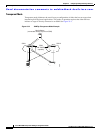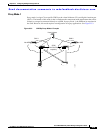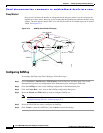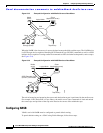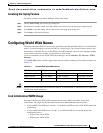
Send documentation comments to mdsfeedback-doc@cisco.com.
24-2
Cisco MDS 9000 Family Fabric Manager Configuration Guide
OL-6965-03, Cisco MDS SAN-OS Release 2.x
Chapter 24 Additional Configuration
The fctrace Feature
The fctrace Feature
The fctrace feature allows you to:
• Trace the route followed by data traffic.
• Compute inter-switch (hop-to-hop) latency.
You can invoke fctrace by providing the FC ID, the N port, or the NL port WWN of the destination. The
frames are routed normally as long as they are forwarded through TE ports.
Once the frame reaches the edge of the fabric (the F port or FL port connected to the end node with the
given port WWN or the FC ID), the frame is looped back (swapping the source ID and the destination
ID) to the originator.
If the destination cannot be reached, the path discovery starts and traces the path up to the point of
failure.
Note The fctrace feature works only on TE ports. Make sure that only TE ports exist in the path to the
destination. In case there is an E port in the path, the fctrace frame is dropped by that switch. Also,
fctrace times out in the originator, and path discovery does not start.
Tip You cannot use the fctrace feature in a locally configured VSAN interface (IPFC interface), but you can
trace the route to a VSAN interface configured in other switches.
Performing an fctrace Operation
To initiate an fctrace using Fabric Manager, follow these steps:
Step 1 Choose Tools > Traceroute. You see the fctrace dialog box.
Step 2 Set the Source Switch, VSAN, and Target Endport for where you want the trace to begin and end.
Step 3 Click Start to start the fctrace. You see updates to the dialog box for each hop. This shows each switch
the trace traverses from the source switch to the target end point. If the destination is unreachable, you
see the hops that the trace traversed until the point where the target could not be found.
Step 4 Click Close to close the dialog box.
The fcping Feature
The fcping feature verifies reachability of a node by checking its end-to-end connectivity. You can
invoke the fcping feature by providing the FC ID or the destination port WWN information.



